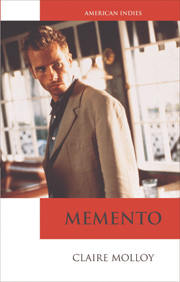Book contents
- Frontmatter
- Contents
- Series Preface
- Acknowledgements
- Dedication
- Introduction: Memento
- 1 Memento and Independent Cinema: A Seductive Business
- 2 Searching for a Slam Dunk: Marketing Memento
- 3 Puzzle Films, Ambiguity and Technologically-enabled Narrative
- 4 Memento as Noir
- 5 So What Really Happened? Memento, Fans and Online Interpretive Strategies
- Notes
- Bibliography
- Index
4 - Memento as Noir
Published online by Cambridge University Press: 05 August 2013
- Frontmatter
- Contents
- Series Preface
- Acknowledgements
- Dedication
- Introduction: Memento
- 1 Memento and Independent Cinema: A Seductive Business
- 2 Searching for a Slam Dunk: Marketing Memento
- 3 Puzzle Films, Ambiguity and Technologically-enabled Narrative
- 4 Memento as Noir
- 5 So What Really Happened? Memento, Fans and Online Interpretive Strategies
- Notes
- Bibliography
- Index
Summary
Memento's exploration of memory and identity would seem to align it with a rash of contemporaneous texts, including Eternal Sunshine of the Spotless Mind (Gondry, 2004), Being John Malkovitch (Jonze, 1999), The Machinist (Anderson, 2004), A Beautiful Mind (Howard, 2001) and The Butterfly Effect (Bress and Gruber, 2004), as well as with earlier films such as Angel Heart (Parker, 1987), Total Recall (Verhoeven, 1990) and Last Year at Marienbad ([L année dernière à Marienbad] Resnais, 1961). However, Memento's narrative structure, flashbacks, voiceover, dream sequences and the generic tropes of the detective thriller, coupled with an unreliable narrator, morally ambiguous hero, femme fatale and corrupt cop, all nod selfconsciously towards film noir. Marketing materials referred to the film as noir, whilst in interviews Christopher Nolan spoke of being a fan of the ‘classic noir’ Double Indemnity (Wilder, 1944), and production notes for the film described Memento as ‘film noir pared down to its most visceral elements, setting its hero adrift in a sea of confusion and paranoia that bit-by-bit causes the audience to question everything that happens right before their eyes’. In critical reviews the film was variously described as a ‘puzzle movie’, an ‘amnesia thriller’, a ‘noirish thriller,’ ‘noir’, ‘meta-noir’, ‘neo-noir’, ‘nouveau noir’ and a ‘revenge thriller’ that ‘uses a favourite plot device of postwar Fruedian film noir’.
- Type
- Chapter
- Information
- Memento , pp. 86 - 97Publisher: Edinburgh University PressPrint publication year: 2010



